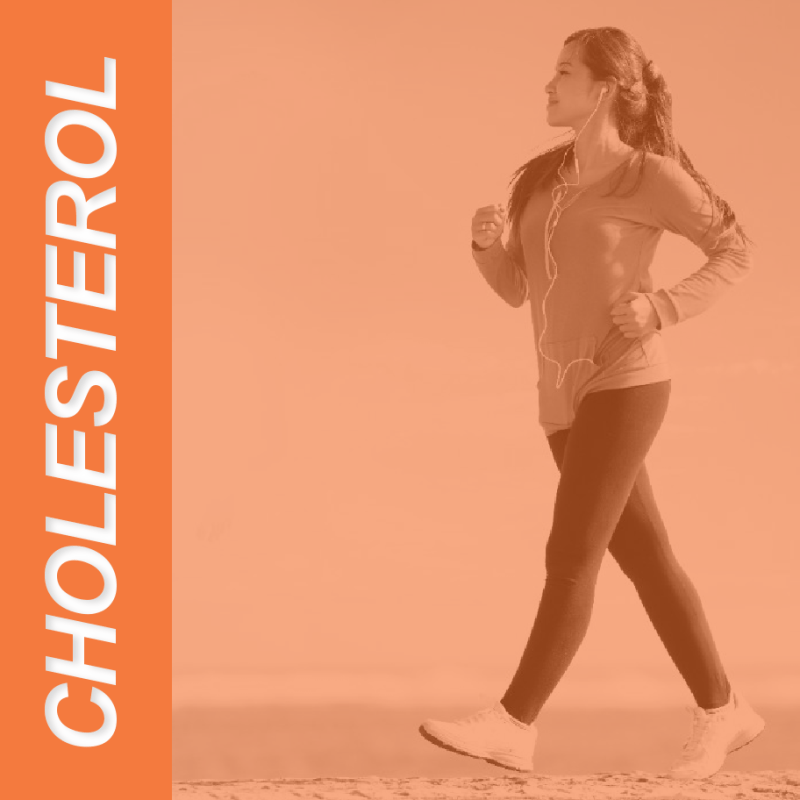
While leading an active life is beneficial to overall health, aerobic exercise specifically helps the human body to maintain a healthy cholesterol profile. Before getting into the details of how and why let’s cover some basics about cholesterol that personal trainers should know.
What is Cholesterol?
Cholesterol is a waxy substance that’s made in the liver. It’s found in the blood and in all of the cells in the human body. It circulates throughout the blood on proteins called “lipoproteins”.
There are different types of cholesterol:
Low-Density Lipoprotein (LDL)
LDL cholesterol can be called “bad” cholesterol because it can build up on the walls of the human body’s blood vessels, referred to as plaque. The more plaque buildup found in the human body’s blood vessels, the narrower they get. Over time, this narrowing obstructs blood flow from the heart and other organs.
The blocked or decreased blood flow can create chest pain (angina), heart attack, and other medical complications. Therefore, having too much LDL can increase the risk for stroke and heart disease.
Very Low-Density Lipoprotein (VLDL)
It may surprise you to learn that VLDL Cholesterol is considered ‘bad’ or unhealthy cholesterol also. This is because VLDL mainly carries triglycerides, which are the most common types of fat in your body. VLDL becomes elevated in the human body as a result of consuming more calories than your body can burn in a day. The excess consumption of calories can lead to excessive amounts of triglycerides in the human body thereby elevating VLDL in your bloodstream. Also, extra triglycerides are stored in fat cells and can be accessed as needed at a later time for energy.
VLDL isn’t mentioned much in mainstream nutrition literature. According to Dr. Lopez-Jimenez, this is because there’s no direct or simple way to measure VLDL cholesterol. This type of cholesterol is typically estimated as part of a triglyceride value.
High-Density Lipoprotein (HDL)
HDL cholesterol is often referred to as the “good” cholesterol because it absorbs LDL cholesterol and carries it back to the liver. It’s the liver’s job to then flush it from the body, or filter and ‘clean it up’ so that the body can reuse what it needs. HDL basically cleans up after LDL, and consequently decreases the plaque buildup on the blood vessels. High levels of HDL cholesterol can reduce your risk for diseases like heart disease and stroke, and complications like atherosclerosis.
Having a high HDL to LDL (HDL/LDL ratio) can offset a total high cholesterol number because of HDL’s positive effects on the body. Overall, cholesterol is important for health. It’s needed for making cell walls, hormones, tissues, bile acid, and vitamin D.
The information in this article doesn’t replace medical advice, but there are things that personal trainers can do to help clients manage their HDL/LDL ratio and an overall healthy cholesterol level.
If you think a client’s cholesterol issue is deeper than your scope of practice, then they should consult with a credentialed medical provider.
Other than that, cholesterol can be managed by diet and lifestyle, including aerobic exercise, as supported by current data.
Why does Aerobic Exercise Benefit HDL?
Aerobic Exercise is repetitive and works multiple muscle groups, but primarily taxes the cardiovascular system. But in order for it to help HDL levels, the American Heart Association (AHA) recommends a minimum of 30 minutes of aerobic exercise five to seven times per week.
If this is a big stretch for your clients, help them start slowly and build up to the AHA’s recommendation.
How Does Aerobic Exercise Benefit HDL?
Aerobic Exercise results in vigorously moving large muscle groups in a low-resistance manner for extended periods of time. Muscles use enzymes to impact these movements. Since aerobic exercise moves a variety of muscles for a substantial period of time, this mode of exercise mobilizes a lot of enzymes.
Every muscle movement the human body performs utilize enzymes (comprised of proteins) , even movements that may not be as taxing as intense training or lengthy aerobic exercise (such as stretching your hands overhead). Since so many enzymes are used during aerobic exercise, the human body must prioritize their replenishment as soon as the human body discontinues aerobic exercise. The first source of protein accessed by the human body to build and restore enzymes post-exercise (aerobic) is its muscles. When the body sources protein from the muscles to build enzymes, this is referred to as catabolism.
During catabolism, the muscles are broken down as a source of protein and then further broken down into enzymes from the protein thereby releasing substantial amounts of LDL cholesterol into the bloodstream. This results in a heightened post-aerobic metabolic state that releases signals to the liver to produce more HDL to ‘clean up’ or remove the released cholesterol into the bloodstream.
The human body’s adaptation to aerobic stress and the catabolism that accompanies it is to create more HDL to filter or flush the cellular release of LDL cholesterol.
If you and/or you’re clients are worried about catabolizing muscles as a result of aerobic exercise, don’t worry! Hours after the aerobic exercise session has been completed, the human body starts to reverse the process of catabolism that occurred earlier (right after the aerobic exercise was completed) and it starts to rebuild the muscles. This process calls for additional HDL cholesterol to be utilized.
Since this process elevates HDL, the HDL continues to circulate in the blood, throughout the body, continuing to send the LDL to the liver to filter and flush it.
This is how aerobic exercise positively impacts HDL Cholesterol.
What types of Aerobic Exercise benefit HDL Levels?
As stated, any form of movement that utilizes the majority of the human body’s major muscle groups in the fat-burning zone for 30 minutes daily, 5-7 times per week.
- Brisk Walking
- Jogging
- Cycling/Biking
- Swimming
- Continuous flow Tai Chi/Qi Gong, Yoga
Whatever form of aerobic exercise your clients decide to do, will work! They can choose different types of exercise throughout the week for variety or they can stick to a couple of their favorites. The key is to do it.
References
https://www.heart.org/en/health-topics/cholesterol/about-cholesterol
https://www.cdc.gov/cholesterol/ldl_hdl.htm#:~:text=HDL%20(high%2Ddensity%20lipoprotein),for%20heart%20disease%20and%20stroke.
https://www.mayoclinic.org/diseases-conditions/high-blood-cholesterol/expert-answers/vldl-cholesterol/faq-20058275
health.clevelandclinic.org/does-exercise-lower-cholesterol/







